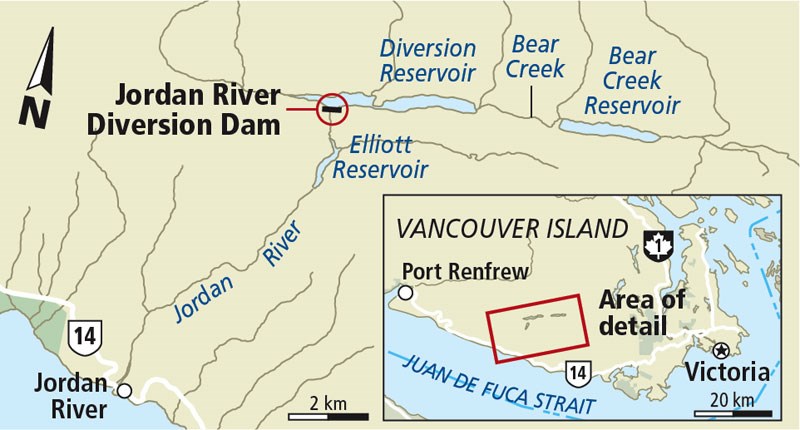Jordan River residents facing displacement because their homes are near a earthquake-vulnerable dam found little comfort at an information meeting on Friday.
The meeting, hosted by B.C. Hydro, was intended to give residents a better idea of why the Crown corporation wants to buy their homes. About 85 people, including some whose houses aren’t threatened, attended.
“It’s the death of a community. And this wasn’t a public meeting, it was a funeral,” said Sean Johnson, who lives in one of 11 homes that B.C. Hydro wants to buy in the Jordan River hamlet.
The decision was made following a six-year, $10-million study of all 79 B.C. Hydro dams in the province. It found the dam in Jordan River is the most likely to fail in an earthquake. A Campbell River dam was also found to be at an increased hazard.
“I appreciate it’s a really difficult issue and it goes to people’s homes and neighbourhoods and communities. There’s a lot of angst,” said Chris O’Riley, vice-president of generation for B.C. Hydro, after the meeting.
“Dam safety and the seismic discussion is complicated, and I think sometimes it’s difficult to get through, given how strong the feelings are.”
According to guidelines set by the Canadian Dam Association, a dam near permanent residences should be equipped to withstand an earthquake with a one in 10,000 chance of occurring. The magnitude of such an earthquake varies by region depending on seismic activity, but in Jordan River, it would be “the Big One” of about magnitude 9.
If the homes were vacated, the dam would only have to be able to withstand much smaller earthquakes with about a one in 1,000 chance of occurring. “We’re good for a wide range of earthquakes here, but we’re challenged with the extreme earthquakes that could come,” O’Riley said.
The dam is still safe, so long as a major earthquake doesn’t occur, he said, which is why B.C. Hydro hasn’t declared a crisis or issued an evacuation order. “We’re not trying to sterilize the area and say people can’t be there, but we’re trying to set ourselves up for extreme events.”
The dam is an important source of power for South Vancouver Island, especially during peak use hours. Replacing the power source with solar and wind is not viable, O’Riley said, and it would take years to establish a gas plant, considered the most viable alternative.
That didn’t appease residents, who called for alternative solutions. “This clearly isn’t about saving lives of people, it’s about saving money,” Johnson said. “If they can actually get the dam up to this regulation standard of one in 10,000, it would cost them money. So they’re saying let’s just get rid of the residents instead.”
He also said the meeting raised new questions, including why B.C. Hydro waited six months to let residents know it planned to acquire their homes.
“The fact we’ve been living in this house of cards for six months … we feel ripped off, we feel [it’s] unfair, we feel that we had a right to know that and to know our risk.”
Some residents whose homes were not threatened, including Pascale Knogliger, showed up to give support. “The hamlet and the point, it’s the heart of our little village. So if you wipe this out, it definitely will change everything for everyone,” she said.



